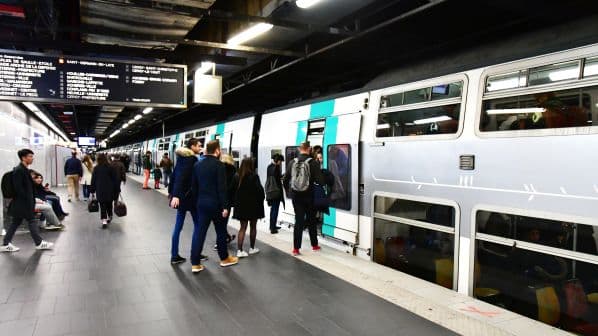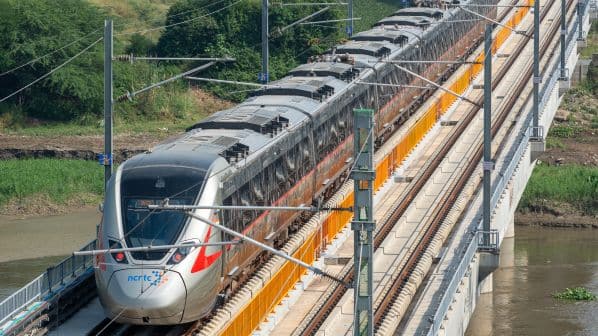REGIONAL railways are currently experiencing something of a renaissance. “Regional services tended to be something in between urban, suburban, and long-distance but no one really cared about them,” says Catalonia Government Railways (FGC) director of strategic and prospective planning, Mr Carles Casas Esplugas. “Now they are gaining a place of their own.”
Casas Esplugas was speaking during a panel session at the International Association of Public Transport’s (UITP) World Congress in Barcelona, entitled Connecting Cities to their Hinterland: The Evolution of Regional and Suburban Railways. The panel was chaired by Ms Vanessa Perez, a senior advisor at the International Union of Railways (UIC), and also included Alstom chairman and CEO, Mr Henri Poupart-Lafarge; Delhi National Capital Region Transport Corporation (NCRTC) managing director, Mr Vinay Kumar Singh; and Keolis North America president and CEO, Mr David Scorey.
Scorey agrees with Casas Esplugas’ assessment, saying that there was considerable doubt over the future of public transport two years ago when Covid-19 lockdowns decimated traffic and balance sheets. However, he says the pandemic has been “a great disrupter in terms of the way that we travel,” actually creating growing momentum for regional rail.
Reduce emissions
Cities are also looking to reduce their CO₂ emissions from transport which, Poupart-Lafarge says, are caused in large part by journeys from the surrounding region into the city centre. “If you want to address the CO₂ emissions, you need to address some of the regional trips,” he says.
There are already examples of railways serving this regional market around the world.
Paris has long been famed for its Regional Express Network (RER), which acts as a combined city-centre underground rail system and suburbs-to-city-centre commuter rail. It also acts as a faster counterpart of the Paris metro in the city centre with fewer stops.
Across the English Channel, London’s new Elizabeth Line is providing connections between the suburbs and city centre. The 21km central section between Paddington and Abbey Wood opened in May 2022, and six months later began carrying through services running right across the capital from Reading or Heathrow Airport in the west to Abbey Wood in the southeast, and from Paddington to Shenfield in the outer eastern suburbs.
Work on a similar project is underway in Delhi with the construction of the Regional Rapid Transit System (RRTS) project across the National Capital Region (NCR). The initial 17km section with five stations between Sahibabad and Duhai depot opened in October and construction is continuing on the 25km section between Muradnagar and Meerut South, with four stations, which is due to open in the next six months. The complete 82km Delhi - Ghaziabad - Meerut corridor will open in 2025.
The project is being implemented by NCRTC, a joint venture between the Indian government and the states of Delhi, Haryana, Rajasthan and Uttar Pradesh.
“The objective of these corridors is to open up new centres of economic activity around the national capital,” Singh says. “At present a lot of economic activity is centred on New Delhi. With these corridors, there will be decentralisation of the economic activity which will lead to the long-term decongestion of Delhi. There will be reverse migration, if we can call it that.”
Examples
There are many more examples around the world where a regional system could be developed but has yet to be implemented.
Casas Esplugas highlights the route between Barcelona, Spain, and Toulouse, France, as an example of where a regional stopping service could bring real benefit. The cities could be connected by rail in only three hours, and there is enough demand between them that Spanish low-cost airline Vueling introduced a tri-weekly service on the 250km route on July 1.
“We’re not exactly going in the right direction when we see airline companies starting new services on routes that take three hours [by train],” he says. “On the commercial side, there are obviously complex challenges to introduce a cross-border service, low demand and very specific needs.

We have to work together within the industry to be able to commercialise an attractive offer and attract customers to the services to make them a reality.”
Organising a cross-border train is just one of the many barriers facing operators and infrastructure managers considering the introduction of regional services.
“We need more versatile types of rolling stock able to serve less dense areas in an economical and an environmentally-friendly way.”
Mr Henri Poupart-Lafarge, Alstom chairman and CEO
Another is the specialist multi-purpose rolling stock required. Metro or light rail trains are designed to carry a higher density of passengers, allowing quick boarding and alighting. In contrast, long-distance trains are often designed to seat more passengers, so they are comfortable for journeys that take several hours, with passengers having access to amenities such as toilets, tables and charging stations. These trains and those operating between city centres and airports also often have additional space to store bulky luggage. However, trains that support both a metro-style service within a city as well as a regional service on the outskirts must be designed to meet all of these needs and more.
“We have these two extreme challenges: on the one hand, we have to be able to have as many trains as possible on one corridor to saturate the infrastructure,” Poupart-Lafarge says. “On the other hand, we need more versatile types of rolling stock able to serve less dense areas in an economical and an environmentally-friendly way.”
Manufacturers are already developing these trains, which may have large vestibules by the doors for passengers to stand in when travelling short distances in the city, but also feature seating in the middle of the car for those travelling longer distances.
Scorey says the introduction of more modern rolling stock also has implications for how trains are operated. In Boston, where Keolis North America has the contract to operate Massachusetts Bay Transportation Authority’s (MBTA) 14 commuter rail lines, trains had previously been equipped with manually operated doors, which require onboard staff to support passengers to board and alight. However, the introduction of new trains with power-operated doors has removed the need for these staff.
“We need to think about the change management too so that we can use the resources that have been freed up from introducing this more modern technology to deliver better customer service, better end-to-end journeys and to create a better experience for passengers,” Scorey says.
Poupart-Lafarge foresees changes to the traction used on lower-density routes where electrification is not economically feasible, with hydrogen and battery seen as the solutions of the future.
Challenges
There can also be challenges with the signalling, as the systems used for regional and urban networks can often be different, making interoperability difficult.
One of the biggest challenges faced by the Crossrail team building London’s new Elizabeth Line was the integration of ETCS on the regional lines and CBTC on the inner-city sections, alongside the legacy TPWS and AWS signalling systems, with automatic changeover between the systems at the appropriate point.
The increased adoption of automatic train operation (ATO) is also in turn leading to the installation of platform screen doors at more suburban and regional stations to match the inner-city stations, improving passenger safety.
New signalling technology can also enable higher service frequencies and shorter headways, providing higher capacity where needed. This is especially true on Delhi’s new RRTS lines, where metro trains will operate alongside mainline trains on the Meerut section of the first RRTS.
As the three priority corridors converge at Sarai Kale Khan station in New Delhi, NCRTC is enabling interoperability by installing hybrid ETCS Level 3 signalling. This combines the latest ETCS standards with ATO over LTE radio, which NCRTC says is the first of its kind in the world. Platform screen doors are also being installed.
The construction of the lines is also being digitalised. For example, the use of a common data environment and building information modelling (BIM) across the project is boosting collaboration between contractors. The project is also benefitting from the use of UAV drone technology and artificial intelligence (AI).
“We are using a lot of advanced technology, which has not been used in India or anywhere else around the world,” Singh says. “The use of technology or the digitalisation of project implementation as well as the operating systems is something which is very much required for this kind of advanced system.”
Technology is also changing how passengers plan their journey and use rail services, and Scorey says a key focus needs to be on how operators can use it to improve the passenger experience.
“Some technologies seem to be very close and they take a long time to be implemented, others seem very far away and suddenly they are accelerated. It’s always a bit of a theoretical exercise that is not always easy to do.”
Mr Carles Casas Esplugas, Catalonia Government Railways (FGC) director of strategic and prospective planning
Delhi is introducing an automated fare collection system based on two types of fare, which can determine whether a passenger has boarded the train in standard or business class.
In Barcelona, consultation with associations representing passengers with reduced mobility, such as the visually impaired, has resulted in accessibility enhancements to ensure these passengers can easily travel by train.
“If rail wants to play this main role as being the backbone of the transport network, it has to welcome everybody and we need to think about technologies which will help everybody to be comfortable inside the train as well,” Poupart-Lafarge says.
In lower-density rural areas, rail operators can coordinate with other modes such as bus companies to provide last-mile services, or to cover periods during the day when demand is lower. This approach has been used by FGC on a low-demand line in the west of Catalonia.
“We publish a coordinated schedule with the bus system, so we’re no longer competing,” Casas Esplugas says. “We try to keep the train running on the busiest hours and complement it with some feeder buses which are coordinated. So it’s full corridor transport provision, not just a single mode vision that we’re trying to provide.”
Ultimately, however, it is important to be flexible and adapt as different technologies reach maturity.
“Everything has to be flexible and able to evolve because we have a wish list but we don’t have a crystal ball to see what’s really going to happen,” Casas Esplugas says. “Some technologies seem to be very close and they take a long time to really be implemented, others seem very far away and suddenly they are accelerated. It’s always a bit of a theoretical exercise that is not always easy to do.”

